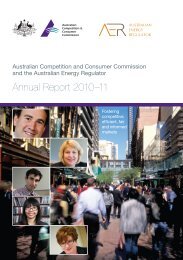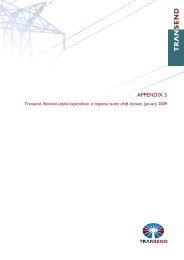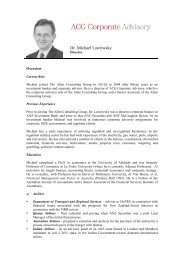Internal consistency of risk free rate and MRP in the CAPM
Internal consistency of risk free rate and MRP in the CAPM
Internal consistency of risk free rate and MRP in the CAPM
Create successful ePaper yourself
Turn your PDF publications into a flip-book with our unique Google optimized e-Paper software.
average long run <strong>in</strong>flation forecast <strong>of</strong> 2.5%, based on <strong>the</strong> middle <strong>of</strong> <strong>the</strong> RBA’s target<br />
b<strong>and</strong> for <strong>in</strong>flation, this is equivalent to nom<strong>in</strong>al economic growth <strong>of</strong> 6.59%. This is also<br />
consistent with <strong>the</strong> 6.9% average expected <strong>rate</strong> <strong>of</strong> growth <strong>in</strong> dividend per share <strong>in</strong> <strong>the</strong><br />
US from 1946 to 2008. 63 By way <strong>of</strong> comparison, equivalent real growth <strong>in</strong> <strong>the</strong> US s<strong>in</strong>ce<br />
1929, 64 start<strong>in</strong>g immediately prior to <strong>the</strong> great depression, was 3.3%. If <strong>the</strong> data series<br />
beg<strong>in</strong>s <strong>in</strong>stead at 1933 <strong>the</strong> real average growth <strong>rate</strong> is 4.0%.<br />
190. The use <strong>of</strong> long run historical economic growth should be dist<strong>in</strong>guished from us<strong>in</strong>g <strong>the</strong><br />
long run historical <strong>MRP</strong> to predict <strong>the</strong> currently prevail<strong>in</strong>g <strong>MRP</strong>. In <strong>the</strong> latter approach<br />
one is us<strong>in</strong>g long run historical <strong>MRP</strong> <strong>and</strong> assum<strong>in</strong>g it is <strong>the</strong> best estimate <strong>of</strong> <strong>the</strong><br />
prevail<strong>in</strong>g <strong>MRP</strong>. This is not ak<strong>in</strong> to how I am us<strong>in</strong>g long run historical economic<br />
growth. In this approach I am us<strong>in</strong>g a long run historical economic growth to <strong>in</strong>form my<br />
view about <strong>the</strong> best estimate <strong>of</strong> a long run future economic growth beyond immediate<br />
term forecasts - which I <strong>the</strong>n use, along with current data on equity prices, short-term<br />
dividend forecasts <strong>and</strong> CGS yields as <strong>the</strong> <strong>in</strong>put <strong>in</strong>to our estimate <strong>of</strong> <strong>the</strong> prevail<strong>in</strong>g<br />
<strong>MRP</strong>. Importantly, I am us<strong>in</strong>g long run historical estimates as a proxy for long run<br />
future estimates – I am not us<strong>in</strong>g <strong>the</strong>m to proxy short run (prevail<strong>in</strong>g) conditions.<br />
63 The appropriate data for Australia is not easily accessible – not<strong>in</strong>g that it is desirable to track dividend per share growth not<br />
dividend growth per se. This means we require an estimate <strong>of</strong> <strong>the</strong> dividends an <strong>in</strong>vestor would receive if <strong>the</strong>y never<br />
re<strong>in</strong>vested dividends nor participated <strong>in</strong> share buy backs. Also, it is desirable to be able to calculate dividend per share<br />
growth on a portfolio that is constantly be<strong>in</strong>g reweighted to match <strong>the</strong> market portfolio over time. Data is available to<br />
perform <strong>the</strong>se calculations from <strong>the</strong> US. The average mean cont<strong>in</strong>uously compound<strong>in</strong>g growth <strong>rate</strong> for dividends,<br />
measured on this basis, on <strong>the</strong> New York Stock Exchange was 6.10% over this period. The st<strong>and</strong>ard deviation <strong>of</strong> <strong>the</strong><br />
annual cont<strong>in</strong>uously compounded growth <strong>rate</strong> was 11%. Assum<strong>in</strong>g <strong>the</strong> dividend growth <strong>rate</strong>s are lognormally distributed<br />
� 0.5�<br />
<strong>the</strong> expected annual dividend growth <strong>rate</strong> is e �<br />
where � is <strong>the</strong> expected annual cont<strong>in</strong>uously compounded growth <strong>rate</strong><br />
2<br />
<strong>and</strong> � is <strong>the</strong> variance <strong>of</strong> <strong>the</strong> annual cont<strong>in</strong>uously compounded growth <strong>rate</strong>.<br />
Competition Economists Group<br />
www.CEG-AP.COM<br />
2<br />
64 The longest published series by <strong>the</strong> Bureau <strong>of</strong> Economic Analysis at <strong>the</strong> US Department <strong>of</strong> Commerce<br />
http://www.bea.gov/national/<strong>in</strong>dex.htm#gdp.<br />
51







